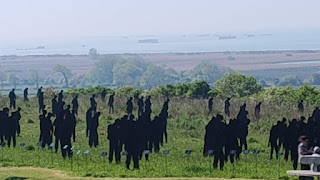Spent a lovely day with the National Trust, we have had drought now for several months with rainfall running at 81mm, the driest spring for over 100 years. With a full day in a very isolated place, we got a forecast of rain all day - not so it was dry, overcast and pretty warm. We were at Orford Ness, formerly recovered salt marsh that has a secret history for over 100 years. Firstly it was a research centre for the Royal Flying Corps from 1913, developing techniques & instrumentation for warplanes. This continued until WW2 when they concentrated on bomb development and the resilience of aircraft to machine gunfire.
This is the only way to get there, I said it was isolated! During the war they developed advanced methods of photographing falling bombs. So many bombs were dropped that you are not allowed off the paths because of the risk of unexploded ordnance. After WW2 they started on atom bomb development and the AWRE took over.
These are the Atom bomb research buildings, designed to contain blast in the event of accidents.
All very top secret.
I am waiting for the MOD police to call.
These are some of the last atom bombs worked on, carried by aircraft & helicopters, could be used as anti-submarine depth charges.
A lot of work was conducted on radar, the first of the chain of WW2 was constructed a few miles down the coastline. There was an advanced US/UK radar built on this site in the 1970's to detect missile launches in the USSR. It was code named Cobra Mist and didn't work. The politicians & engineers blamed the Russian spy trawlers, but I'm not sure, it sounds like an excuse no one could disprove.
This is the Black Beacon, an experimental aircraft radio navigation aide from the 1930's.
There is a resident artist from Suffolk University who has workshop right at the end of the island, Sarah was working on pinhole camera shots that gave nod to the bomb ballistic photos and some interesting wind driven art works.
Orford Ness is now a nature reserve with hares, Chinese water deer, seals and a varied bird population. It's a desolate place with a kind of mysterious beauty.




































































